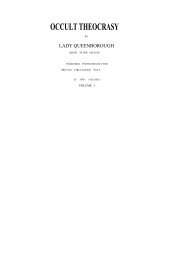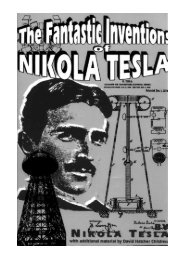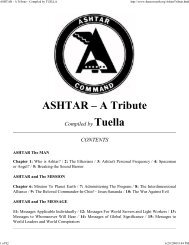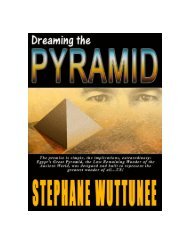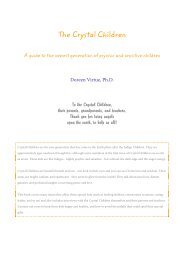the fantastic inventions of nikola tesla - Exopolitics Hong Kong
the fantastic inventions of nikola tesla - Exopolitics Hong Kong
the fantastic inventions of nikola tesla - Exopolitics Hong Kong
Create successful ePaper yourself
Turn your PDF publications into a flip-book with our unique Google optimized e-Paper software.
Here, for instance, I have two plates, R R, <strong>of</strong> hard rubber (Fig. 9), upon which I have glued two very thin wires w w,<br />
so as to form a name. The wires may be bare or covered with <strong>the</strong> best insulation—it is immaterial for <strong>the</strong> success <strong>of</strong><br />
<strong>the</strong> experiment. Well insulated wires, if anything, are preferable. On <strong>the</strong> back <strong>of</strong> each plate, indicated by <strong>the</strong> shaded<br />
portion, is a tinfoil coating<br />
I t. The plates are placed in line at a sufficient distance to prevent a spark passing from one to <strong>the</strong> o<strong>the</strong>r wire. The<br />
two tinfoil coatings I have joined by a conductor C, and <strong>the</strong> two wires I presently connect to <strong>the</strong> terminals <strong>of</strong> <strong>the</strong><br />
coil. It is now easy, by varying <strong>the</strong> strength and frequency <strong>of</strong> <strong>the</strong> currents through <strong>the</strong> primary, to find a point at<br />
which <strong>the</strong> capacity <strong>of</strong> <strong>the</strong> system is best suited to <strong>the</strong> conditions, and <strong>the</strong> wires become so strongly luminous that,<br />
when <strong>the</strong> light in <strong>the</strong> room is turned <strong>of</strong>f <strong>the</strong> name formed by <strong>the</strong>m appears in brilliant letters.<br />
It is perhaps preferable to perform this experiment with a coil operated from an alternator <strong>of</strong> high frequency, as<br />
<strong>the</strong>n, owing to <strong>the</strong> harmonic rise and fall, <strong>the</strong> streams are very uniform, though <strong>the</strong>y are less abundant than when<br />
produced with such a coil as <strong>the</strong> present. This experiment, however, may be performed with low frequencies, but<br />
much less satisfactorily.<br />
FIG. 9.—WIRES RENDERED INTENSELY LUMINOUS. FIG. 10.—LUMINOUS DISCS.<br />
When two wires, attached to <strong>the</strong> terminals <strong>of</strong> <strong>the</strong> coil, are set at <strong>the</strong> proper distance, <strong>the</strong> streams between <strong>the</strong>m may<br />
be so intense as to produce a continuous luminous sheet. To show this phenomenon I have here two circles, C and c<br />
(Fig. 10), <strong>of</strong> ra<strong>the</strong>r stout wire, one being about 80 centimetres and <strong>the</strong> o<strong>the</strong>r 30 centimetres in diameter. To each <strong>of</strong><br />
<strong>the</strong> terminals <strong>of</strong> <strong>the</strong> coil I attach one <strong>of</strong> <strong>the</strong> circles. The supporting wires are so bent that <strong>the</strong> circles may be placed<br />
in <strong>the</strong> same plane, coinciding as nearly as possible. When <strong>the</strong> light in <strong>the</strong> room is turned <strong>of</strong>f and <strong>the</strong> coil set to<br />
work, you see <strong>the</strong> whole space between <strong>the</strong> wires uniformly filled with streams, forming a luminous disc, which<br />
could be seen from a considerable distance, such is <strong>the</strong> intensity <strong>of</strong> <strong>the</strong> streams. The outer circle could have been<br />
much larger than <strong>the</strong> present one, in fact, with this coil I have used much larger circles, and I have been able to<br />
produce a strongly luminous sheet, covering an area <strong>of</strong> more than one square metre, which is a remarkable effect<br />
with this very small coil. To avoid uncertainty, <strong>the</strong> circle has been taken smaller, and <strong>the</strong> area is now about 0.43<br />
square metre.<br />
The frequency <strong>of</strong> <strong>the</strong> vibration, and <strong>the</strong> quickness <strong>of</strong> succession <strong>of</strong> <strong>the</strong> sparks between <strong>the</strong> knobs, affect to a marked<br />
degree <strong>the</strong> appearance <strong>of</strong> <strong>the</strong> streams. When <strong>the</strong> frequency is very low, <strong>the</strong> air gives way in more or less <strong>the</strong> same<br />
manner, as by a steady difference <strong>of</strong> potential, and <strong>the</strong> streams consist <strong>of</strong> distinct threads, generally mingled with<br />
thin sparks, which probably correspond to <strong>the</strong> successive discharges occurring between <strong>the</strong> knobs. But when <strong>the</strong><br />
frequency is extremely high, and <strong>the</strong> arc <strong>of</strong> <strong>the</strong> discharge produces a very loud but smooth sound—showing both<br />
that oscillation takes place and that <strong>the</strong> sparks succeed each o<strong>the</strong>r with great rapidity—<strong>the</strong>n <strong>the</strong> luminous streams<br />
formed are perfectly uniform. To reach this result very small coils and jars <strong>of</strong> small capacity should be used. I take<br />
two tubes <strong>of</strong> thick Bohemian glass, about 5 centimetres in diameter and 20 centimetres long. In each <strong>of</strong> <strong>the</strong> tubes I<br />
slip a primary <strong>of</strong> very thick copper wire. On <strong>the</strong> top <strong>of</strong> each tube I wind a secondary <strong>of</strong> much thinner gutta-percha<br />
covered wire. The two secondaries I connect in series, <strong>the</strong> primaries preferably in multiple arc. The tubes are <strong>the</strong>n<br />
placed in a large glass vessel, at a distance <strong>of</strong> 10 to 15 centimetres from each o<strong>the</strong>r, on insulating supports, and <strong>the</strong><br />
vessel is filled with boiled-out oil, <strong>the</strong> oil reaching about an inch above <strong>the</strong> tubes. The free ends <strong>of</strong> <strong>the</strong> secondary



